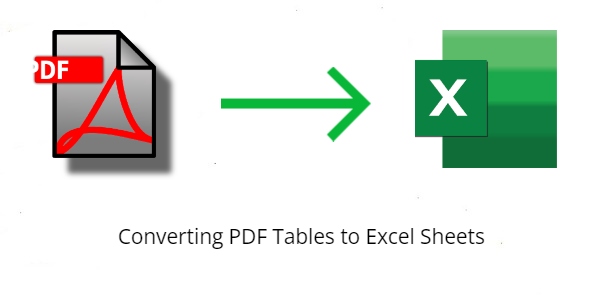In today’s digital age, data is more abundant and valuable than ever before. From small businesses to large corporations. The ability to efficiently and accurately organize, analyze, and manipulate data is crucial for success. One common method of presenting data is through PDF tables. Which offers a convenient and easily shareable format. However, when it comes to working with this data, PDFs can often be limiting and time-consuming. That’s where the power of transformation comes in. By converting PDF tables to Excel sheets. Users can unlock a whole new level of flexibility and functionality. This process allows for the manipulation and analysis of data in a dynamic and customizable manner. Ultimately leading to increased efficiency and improved decision-making.
Unlock the potential of seamless data manipulation with the power of transformation. As you effortlessly Convert pdf to excel sheets. Streamlining information accessibility and enhancing analytical capabilities. In this article, we will delve into the world of PDF and Excel. You were exploring the benefits of converting tables. And providing step-by-step instructions on how to do so. Whether you’re a data analyst or a business owner. Or simply someone looking to streamline your workflow. The power of transformation through PDF to Excel conversion is a game-changer that should not be overlooked.

Table of contents
Streamline data analysis with Excel
Excel is a powerful tool that goes beyond just organizing and calculating data. It offers a wide range of features and functionalities that can streamline the data analysis process. With Excel’s robust formulas, functions, and formatting options. Analysts can easily manipulate and analyze large datasets to derive meaningful insights. Excel also provides tools for creating charts, graphs, and pivot tables. Allowing users to visually represent their data and identify trends or patterns more effectively.
Additionally, Excel offers advanced data analysis add-ins, such as Solver and Data Analysis Toolpak. That enables users to perform complex statistical analysis and optimize decision-making processes. By leveraging the capabilities of Excel. Professionals can efficiently transform raw data into valuable information. Saving time and effort in data analysis tasks.
Simplify data entry and organization
In today’s data-driven world, the ability to simplify data entry. And organization is crucial for businesses and professionals alike. Managing large volumes of data can be a daunting task. But with the right tools and techniques, it can be streamlined and made more efficient. By utilizing features like data validation and drop-down lists in Excel. Data entry can be standardized, minimizing errors and ensuring consistency.
Furthermore, Excel’s sorting and filtering functions allow for easy organization and categorization of data. Making it easier to locate information and analyze trends. With the ability to create templates and utilize automation tools. Such as macros, the process of data entry and organization can be further simplified. Saving valuable time and increasing productivity. By harnessing the power of Excel, professionals can transform their data management processes. And improving accuracy, efficiency, and decision-making capabilities.
Enhance collaboration and communication
Effective collaboration and communication are essential for the success of any organization. By leveraging the capabilities of Excel. Teams can enhance their collaborative efforts and streamline communication processes. Excel allows for real-time sharing and editing of spreadsheets. Enabling multiple team members to work on the same document simultaneously. This eliminates the need for back-and-forth emails. And ensures that everyone is accessing the most up-to-date information.
Additionally, Excel’s commenting feature allows for easy communication within the spreadsheet itself. Eliminating the need for separate communication channels. Furthermore, Excel’s data visualization tools. As charts and graphs, provide a clear and concise way to present data and insights. Facilitating effective communication and understanding among team members. By harnessing the power of Excel, organizations can greatly enhance their collaborative capabilities. And improve overall communication efficiency.
Save time and increase efficiency
In today’s fast-paced business environment. Saving time and increasing efficiency are essential for organizations to stay competitive. By utilizing advanced software solutions, such as converting PDF tables to Excel sheets. Companies can unlock a multitude of benefits. This transformation not only allows for seamless data transfer. But also enables easy manipulation and analysis of information. By eliminating the need for manual data entry and tedious formatting. This process significantly reduces the time and effort required to extract valuable insights from complex documents. With accurate and organized data readily available in Excel. Employees can make informed decisions faster.
Enhancing productivity and driving overall efficiency within the organization. Embracing the power of transformation through converting PDF tables to Excel sheets. And empowers businesses to streamline their operations. Optimize processes, and ultimately achieve greater success.
Increase accuracy and reduce errors
One of the key advantages of converting PDF tables to Excel sheets is the ability to increase accuracy. And reduce errors in data management. Manual data entry can be prone to human error. Leading to inaccuracies that can have significant consequences for businesses. By automating the process of extracting data from PDF tables. And transferring it to Excel, the risk of transcription errors is minimized.
Additionally, Excel provides built-in features for data validation and error checking. Allowing for quick identification and correction of any inconsistencies or mistakes. This ensures that the data being utilized for analysis or decision-making is reliable and precise. By harnessing the power of transformation through converting PDF tables to Excel sheets. Organizations can enhance data accuracy, and mitigate errors. And ultimately make more informed business decisions.
Conclusion
The ability to transform PDF tables into Excel sheets. That has revolutionized the way businesses and individuals handle data. With the power of conversion. Complex and time-consuming tasks can now be completed efficiently and accurately. As technology continues to evolve and improve. We can only expect more advancements in the field of data management. By utilizing tools and software like PDF to Excel converters. We can streamline our processes and increase productivity. Leading to the success and growth of our businesses.